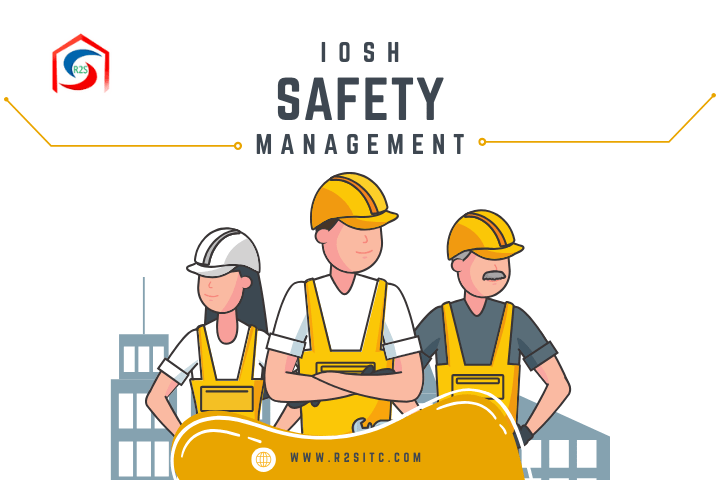Fire and Safety Training: Thorough Guide by R2SITC
Any environment must prioritize fire safety , and having the proper information on hand can make all the difference in an emergency. We explore the complexities of fire safety in this comprehensive handbook, provided to you by R2SITC, covering everything from emergency response to prevention.
Understanding Fire Dynamics
1. Defining the Fire Triangle:
A key idea in fire science is the Fire Triangle, which clarifies the three prerequisites that must exist for a fire to start and spread. These elements consist of:
– Heat: The Fire Triangle’s initial component. Heat is the energy needed to bring a substance’s temperature up to its ignition point. It can originate from a number of things, including electrical appliances, open fires, and even unplanned chemical reactions.
– Fuel: The second component is fuel. It encompasses any substance capable of burning. Typical examples are flammable gasses, wood, paper, and gasoline. The kind and state of the fuel are major factors in influencing how quickly and intensely a fire spreads.
– Oxygen: An essential component of combustion, oxygen is the third element. An atmosphere high in oxygen is ideal for fires. At a specific temperature, known as the ignition point, oxygen and fuel mix to form combustion, which releases heat and keeps the fire going.
2. How Fires Spread:
To effectively build fire safety measures, it is imperative to comprehend the spread of fires. There are three main ways that fires spread:
– Conduction: The direct flow of heat between two materials. For instance, heat from a fire in one room might spread to adjacent places through the ceiling, floors, and walls.
– Convection: Heat is transferred through gases or liquids. Heat is transferred to colder regions by rising hot gasses or air. This may cause the fire to spread to nearby areas or throughout the room.
– Radiation: It is the movement of heat via electromagnetic waves. At a distance, combustible items can catch fire due to radiant heat. It has a major role in the quick spread of fires in small areas.

3. Classes of Fires:
Several sorts of fires are distinguished according to the kind of fuel used. There are specific types of extinguishing agents needed for each class. The classes that are widely acknowledged are:
- Class A (Ordinary Combustibles) : Fires involving common combustible materials, such as wood, paper, cloth, and some plastics.
- Class B (Flammable Liquids and gasses): Fires started by gasses like propane or flammable liquids like gasoline or oil.
- Class C (Electrical Fires) : Fires involving electrified electrical equipment. To avoid electric shock, water-based extinguishers are not appropriate for certain types of fires.
- Class D (Combustible Metals): Fires involving metals that can catch fire, such as titanium or magnesium. It is necessary to use specialized extinguishing agents.
- Class K (Kitchen Fires): These are fires that start in kitchen appliances and frequently involve fats and oils. There is use of specialized extinguishing agents meant for high-temperature flames.
The Importance of Fire Safety
1. Real-Life Consequences:
Prioritizing fire safety is greatly aided by knowledge of the practical repercussions of fires. Devastating effects of fires can be experienced by people, communities, and the environment. Among the repercussions are:
– Deaths: Tragically, fires can cause the loss of life. During a fire, breathing in smoke and harmful gasses puts people’s health at risk right away.
– Injuries: Burns, breathing issues, and trauma are among the serious injuries that fire survivors frequently suffer. It takes a lot of medical resources to treat these injuries.
– Property Damage: Homes, companies, and infrastructure are all susceptible to significant damage from fires. Rebuilding and restoring damaged possessions can come at a hefty financial cost.
– Emotional and Psychological Trauma: Survivors of a fire may experience long-lasting emotional scarring. A sense of security, memories, and possession loss can all lead to long-term psychological trauma.
– Displacement and Homelessness: When people and families are forced to flee their homes due to fires, this can result in both displacement and, occasionally, homelessness. It takes time and money to rebuild lives and communities.
2. Legal and Regulatory Compliance:
It is both a duty and a legal need to ensure fire safety regulations and laws are followed. Building codes, fire safety standards, and other rules are created and enforced by governments and municipal authorities in order to:
– Prevent Fires: Specific actions to reduce the risk of fire are frequently required by regulations. Examples of these actions include the installation of sprinkler systems, fire alarms, and fire-resistant building materials.
– Guarantee Occupant Safety: Adhering to safety rules guarantees that structures are made and kept in a way that keeps occupants safe.
– Promote Emergency Response: Regulations specify emergency escape routes, firefighting equipment access, and other essential elements of a successful disaster response.
– Prevent Legal Repercussions: Failure to comply may lead to penalties, business closures, and, in extreme circumstances, criminal prosecutions. Adherence to regulations indicates a dedication to public security.
3. The Role of Individuals in Fire Prevention:
People are essential in averting fires and lessening their effects. Among one’s personal obligations in preventing fires are:
– Awareness and Education: Having a thorough understanding of fire hazards and protective measures enables people to make well-informed decisions. Being trained in fire safety procedures improves readiness.
– Reporting dangers: Timely intervention and preventive measures are made possible by promptly reporting potential fire dangers, such as malfunctioning wiring or gas leaks.
– Correct utilize of Fire Safety Equipment: It’s critical to understand how to utilize fire blankets, extinguishers, and other safety equipment. Such items should be known to people and their location shoulded.
– Evacuation Readiness: Practicing fire drills and knowing the routes of evacuation guarantee a quick and organized escape in an emergency.
– Community Engagement: Raising community understanding of fire safety issues helps to create a shared commitment to putting out flames and reducing hazards.
R2SITC’s Expertise in Fire and Safety Training
1. Overview of R2SITC’s Credentials:
R2SITC, or Road 2 Safety International Training Centre , stands as a beacon of excellence in providing comprehensive training in fire safety, emergency response, and safety management. The institute’s credentials exemplify its commitment to delivering top-tier training services:
– Accreditations: R2SITC’s training programs are of high quality and comply to worldwide standards, as evidenced by the accreditations it has received from pertinent industry authorities.
– Certifications: Following the complete completion of its training programs, the institute awards certifications. The industry recognizes these credentials widely, attesting to the participants’ acquired expertise.
– Industry Recognition: The safety and emergency response sector respects and acknowledges R2SITC. Individuals, companies, and regulatory agencies have come to trust it because of its reputation for providing high-quality training.
– Continuous Improvement: The institute exhibits a dedication to ongoing development by bringing the most recent developments in safety and emergency response procedures into its curriculum and updating it on a regular basis to conform to changing industry standards.
– Testimonials and Success Stories: The credibility and efficacy of R2SITC are further reinforced by the positive remarks left by previous participants and the success stories of those who have benefited from the program.
2. Experienced Instructors:
A key factor in R2SITC’s success is its group of knowledgeable teachers who infuse the training programs with a plethora of information and practical experience:
– Subject Matter Experts: With years of experience, R2SITC instructors are subject matter experts in the areas of safety management, emergency response, and fire safety.
– Practical Experience: Teachers frequently have a great deal of first-hand experience working with participants in emergency circumstances, which gives them significant insights.
– Pedagogical Excellence: R2SITC instructors are highly qualified educators who use efficient teaching strategies to make sure participants gain both theoretical knowledge and practical skills.
– Dedication to Professional Development: The institute makes investments in its teachers’ continuous professional growth to make sure they are up to date on the newest techniques, innovations, and trends in the field.
3. Tailored Training Programs:
R2SITC distinguishes itself by providing customized training programs made to satisfy the particular requirements of various audiences:
– Customization: Training curricular are tailored to meet the unique needs of various businesses, associations, and people. This guarantees that the training provided to participants is pertinent and focused.
– Flexibility: R2SITC is aware of the various needs and schedules that its members have. In order to meet different needs, the institute provides flexible training schedules that include both on-site and online options.
– Extensive Curriculum: The courses cover a wide range of subjects, from advanced emergency response tactics to fundamental fire safety. This all-encompassing strategy guarantees that participants are ready for a variety of situations.
– Client Collaboration: R2SITC works closely with customers to comprehend their specific needs and safety objectives. Based on this understanding, training programs are customized to meet organizational goals.
How to Enroll in R2SITC’s Fire Safety Training Programs
1. Steps to Registration:
Accessing the institute’s beneficial training programs is made simple and easy for participants by the simple and user-friendly registration process offered by R2SITC. Usually, the steps are as follows:
– Online Registration gateway: Via its official website, R2SITC offers a specific online registration gateway. By enabling users to establish accounts, this site offers a safe and organized registration platform.
– User-friendly Interface: Participants are guided through the necessary stages with clear explanations and prompts thanks to the registration interface’s intuitive design. This guarantees a smooth and effective registration process.
– Individual Data: All participants must enter their personal data, which includes contact information and pertinent history. This enables R2SITC to customize the training program to meet the needs of each student.
– Course Selection: During the registration process, you must choose the training course or program you want to enroll in from a long list of options. Detailed explanations and information about every subject assist students in making well-informed decisions.
– Payment Methods: R2SITC provides clear and safe methods of payment. A breakdown of related fees is provided by the registration system, and participants have a selection of payment options.
– Enrollment confirmation and Welcome Kit: Following a successful registration, participants receive an enrollment confirmation and a welcome kit that includes important details including schedules, course materials, and any requirements.
2. Course Offerings and Specializations:
R2SITC is proud of the wide range of specializations and courses it offers, meeting the individual demands of participants from a variety of industries. The course catalog at the institute usually consists of:
– Basic Fire Safety Training: This includes instruction on basic principles, fire prevention tactics, and first reaction methods.
– Advanced Emergency Response Courses: Specialized education centered on complicated emergency scenarios, incident management, and advanced abilities.
– Training in Occupational Safety and Health: Covers risk assessment, workplace safety, and adherence to OSHA regulations.
– Customized Industry-Specific Training: Programs designed to address industry-specific risks and issues, such as those found in the manufacturing, healthcare, and construction sectors, among others.
– Options for Online and On-Site Training: R2SITC offers flexibility in training options, letting participants select the mode that best fits their schedules and tastes.
– Professional Certifications: By improving participants’ credentials and job prospects, courses frequently result in nationally recognized professional certifications.
3. Testimonials from Previous Participants:
The experiences of people who have participated in R2SITC’s training programs are the true barometer of the organization’s efficacy. Testimonials from past attendees provide strong validation of the institute’s impact:
– Diverse Perspectives: The testimonials demonstrate the wide range of industries, jobs, and backgrounds from which R2SITC’s training can be used.
– Success Stories: To demonstrate the real-world advantages of the programs, participants frequently share success stories about how they have applied the skills they have learned throughout R2SITC training.
– Instructor Expertise: Testimonials may highlight the knowledge and direction offered by R2SITC’s seasoned instructors, highlighting the high caliber of instruction.
– Recommendations: Good reviews frequently provide recommendations for R2SITC, highlighting the institute’s track record of providing insightful and lasting training sessions.
– Community Impact: Participants can discuss how their companies or communities now have a safer culture as a result of R2SITC’s training.
Conclusion:
To sum up, becoming an expert in fire and safety is a continuous process that calls for cooperation, planning, and knowledge. R2SITC is a source of knowledge that points people and organizations in the direction of a more secure and resilient future. Use this thorough handbook as a road map to help you comprehend, put into practice, and promote fire safety in all facets of your life. Visit R2SITC to grab the best fire and safety training.









